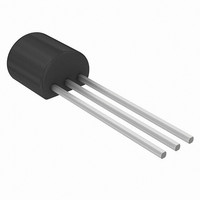AD22100AT Analog Devices Inc, AD22100AT Datasheet - Page 9

AD22100AT
Manufacturer Part Number
AD22100AT
Description
IC TEMP SENSOR VOUT TO-92-3
Manufacturer
Analog Devices Inc
Datasheet
1.AD22100ARZ.pdf
(12 pages)
Specifications of AD22100AT
Rohs Status
RoHS non-compliant
Sensing Temperature
-50°C ~ 150°C
Output Type
Voltage
Voltage - Supply
4 V ~ 6.5 V
Accuracy
±1°C
Package / Case
TO-226-3, TO-92-3 (TO-226AA)
Peak Reflow Compatible (260 C)
No
Ic Function
Temperature Sensor IC
Termination Type
Through Hole
Leaded Process Compatible
No
Mounting Type
Through Hole
Operating Temperature Range
-50°C To +150°C
Lead Free Status / RoHS Status
Contains lead / RoHS non-compliant
Response of the AD22100 output to abrupt changes in ambient
temperature can be modeled by a single time constant t expo-
nential function. Figure 10 shows the typical response time
plots for a few media of interest.
The time constant t is dependent on θ
ties of the chip and the package. Table 6 lists the effective t (time
to reach 63.2% of the final value) for a few different media.
Copper printed circuit board connections were neglected in the
analysis; however, they will sink or conduct heat directly
through the AD22100’s solder plated copper leads. When faster
response is required, a thermally conductive grease or glue
between the AD22100 and the surface temperature being
measured should be used.
100
90
80
70
60
50
40
30
20
10
0
0
10
MOVING
AIR
ALUMINUM
BLOCK
20
STILL AIR
Figure 10. Response Time
30
40
TIME (sec)
50
60
JA
and the thermal capaci-
70
80
90
100
Rev. D | Page 9 of 12
MICROPROCESSOR A/D INTERFACE ISSUES
The AD22100 is especially well suited to providing a low cost
temperature measurement capability for microprocessor/
microcontroller based systems. Many inexpensive 8-bit micro-
processors now offer an onboard 8-bit ADC capability at a
modest cost premium. Total cost of ownership then becomes a
function of the voltage reference and analog signal conditioning
necessary to mate the analog sensor with the microprocessor
ADC. The AD22100 can provide an ideal low cost system by
eliminating the need for a precision voltage reference and any
additional active components. The ratiometric nature of the
AD22100 allows the microprocessor to use the same power
supply as its ADC reference. Variations of hundreds of mil-
livolts in the supply voltage have little effect as both the
AD22100 and the ADC use the supply as their reference. The
nominal AD22100 signal range of 0.25 V to 4.75 V (−50°C to
+150°C) makes good use of the input range of a 0 V to 5 V
ADC. A single resistor and capacitor are recommended to pro-
vide immunity to the high speed charge dump glitches seen at
many microprocessor ADC inputs (see Figure 2).
An 8-bit ADC with a reference of 5 V will have a least signifi-
cant bit (LSB) size of 5 V/256 = 19.5 mV. This corresponds to a
nominal resolution of about 0.87°C.
USE WITH A PRECISION REFERENCE AS THE SUPPLY
VOLTAGE
While the ratiometric nature of the AD22100 allows for system
operation without a precision voltage reference, it can still be
used in such systems. Overall system requirements involving
other sensors or signal inputs may dictate the need for a fixed
precision ADC reference. The AD22100 can be converted to
absolute voltage operation by using a precision reference as the
supply voltage. For example, a 5.00 V reference can be used to
power the AD22100 directly. Supply current will typically be
500 µA, which is usually within the output capability of the
reference. Using a large number of AD22100s may require an
additional op amp buffer, as would scaling down a 10.00 V ref-
erence that might be found in instrumentation ADCs typically
operating from ±15 V supplies.
1
2
The time constant t is defined as the time to reach 63.2% of the final
temperature change.
1200 CFM.
AD22100












